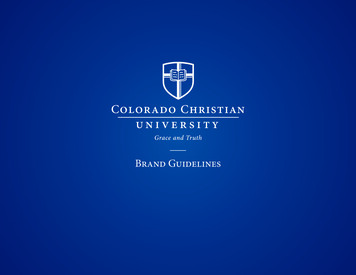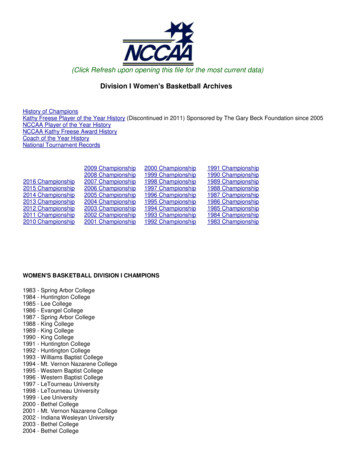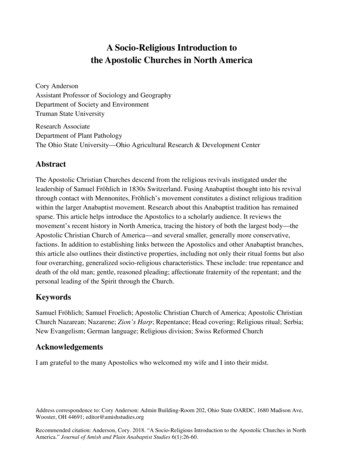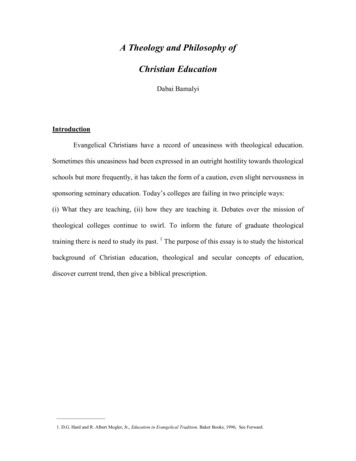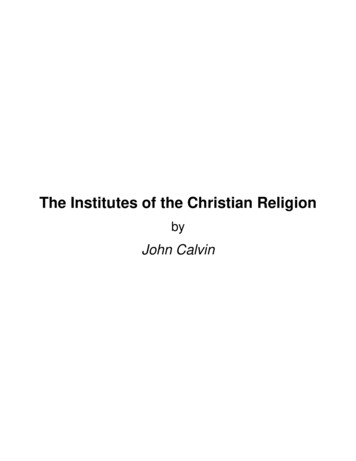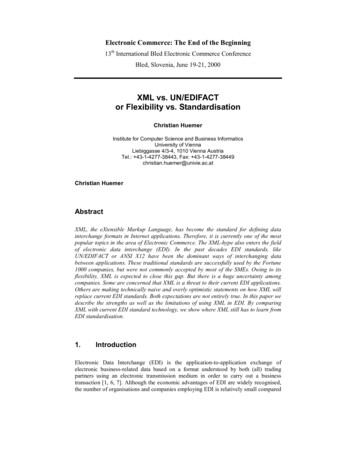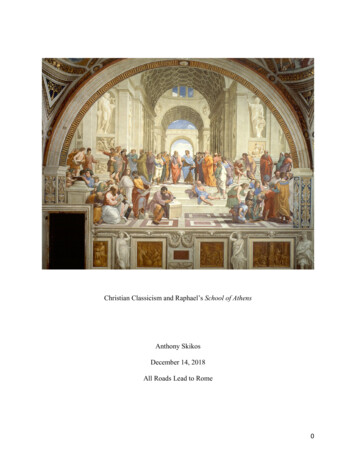
Transcription
Christian Classicism and Raphael’s School of AthensAnthony SkikosDecember 14, 2018All Roads Lead to Rome0
The classical culture and civilization of antiquity constituted one of the primary drivingforces of the Italian Renaissance, as humanists of the period strived for the ideals and principleswhich classical civilization valued. Seeking to reconcile and connect the classical learning andphilosophy of Greece and Rome with Christian thought, the humanist movement promotedChristian classicism and stressed the importance of understanding the wisdom of old in light ofChrist’s revealed truth. For them, the learning of antiquity should ultimately direct one towardsGod by helping him or her to grow in knowledge and the pursuit of truth. This harmonization ofclassical Greek thought with Christian thought manifests itself throughout the art of theRenaissance, as the artist, like the humanist, promoted classical ideals in light of Christianity.Accordingly, the art of the Renaissance reflects Christian classicism and physically expresses theintellectual ideas underlying the Renaissance movement. Raphael’s School of Athens stands asan embodiment of this idea, as it very clearly emphasizes Greek learning but subtly directs theviewer towards ultimately understanding the work in light of Christian wisdom.Before exploring and analyzing their manifestation in Raphael’s School of Athens, it isimportant to understand humanism and some of the intellectual sources and ideas behind theRenaissance movement. Although classicism was not the only factor in the Renaissancemovement, it played an essential role in the transformation which the movement brought about,as the Renaissance consisted greatly in a shared set of ideological principles and philosophicconcerns which were embodied by artists and humanists. 1 In the words of the important scholarof the Italian Renaissance Jacob Burckhardt, the humanists were those individuals who “acted asmediators between their own age and a venerated antiquity, and made the latter a chief elementBaron, Hans. The Crisis of the Early Italian Renaissance: Civic Humanism and Republican Liberty in an Age ofClassicism and Tyranny. Princeton University Press, 1993. Pg. 411
in the culture of the former.” 2 Fundamental to the idea of humanism is thus an emphasis onclassical learning and the desire to connect antiquity to present culture. Dante, Petrarch, andBoccaccio, were among the first and most important of such figures, and Petrarch in particular isconsidered the father of humanism. Through these early humanists and later figures like them,“A belief in the identity of the human spirt under all previous manifestations, and in itsuninterrupted continuity, was generated.” 3 Connecting themselves to antiquity under this idea ofantiquity, “men found that in classical as well as biblical antiquity existed an ideal of human life,both moral and intellectual, by which they might profit in the present.” 4 Accordingly, striving toachieve this ideal, the humanists “looked to that remote past as a guide to their own conduct inthe present.” 5 Whereas the Middle Ages largely viewed the Greek and Latin classics as“antagonistic to the principles of Christian Ethics,” the Renaissance rather viewed them asinstrumentally good in enhancing the morality of man. 6 Tying together classical learning andChristian thought was thus a primary focus of the humanist movement, and humanism can thusbe seen as Christian classicism which is ultimately directed at understanding antiquity in light ofChristianity. In the 16th century, the time of Raphael, classicism was especially prominent, as“The time had come for the emergence of a brand of classicism characterized by a singleminded, even militant dedication to antiquity such as had been unknown to earlier centuries.” 7(Baron 4). The desire for a “restored Roman imperial culture” expressed itself linguistically inthe poetry and literature of the time, architecturally through monuments by architects such asBurckhardt, Jacob. The Civilization of the Renaissance in Italy. Translated by S. G. C. Middlemore, PenguinBooks, 2004. Pg. 1353Symonds, John Addington, and Alfred Pearson. A Short History of the Renaissance in Italy. Cooper SquarePublishers, Inc., 1966. Pg. 64Symonds, A Short History of the Renaissance in Italy. Pg. 65Rowland, Ingrid D. The Culture of the High Renaissance: Ancients and Moderns in Sixteenth-Century Rome.Cambridge University Press, 2011. Pg. 116Symonds, A Short History of the Renaissance in Italy. Pg. 1217Baron, Hans. The Crisis of the Early Italian Renaissance: Civic Humanism and Republican Liberty in an Age ofClassicism and Tyranny. Princeton University Press, 1993. Pg. 422
Bramante, and artistically through men such as Michelangelo and Raphael. 8 As Symondseloquently says, “It has been granted only to two nations, the Greeks and the Italians, and to thelatter only at the time of the Renaissance, to invest every place and variety of intellectual energywith the form of art.” 9 Accordingly, just as the Greeks expressed their intellectual ideas throughtheir beautiful classical art, so too did the Italians during the Renaissance, which further reflectsthe connection between the two cultures. There is thus a strong connection between humanismand art in the Renaissance, as art becomes a visual manifestation of the philosophic ideasunderlying the movement and the artist a creative force expressing the values of his time.Reflecting the very complex and powerful ways in which an artist is able to communicatephilosophic ideas, Raphael’s School of Athens stands as an embodiment of Christian Classicism.Painted by Raffaello Sanzio da Urbino, or Raphael as he is commonly known, the School ofAthens is a Renaissance fresco within the Stanza of the Segnatura, one of the Raphael rooms inthe Vatican Palace. Commissioned by Pope Julius II to decorate his library and completedbetween 1509 and 1511, the fresco portrays the classical philosophers and thinkers of the preChristian world, actively engaging in discussion and other activities of learning. 10 Theimportance and influence of the School of Athens in art is monumental, and the work stands asone of the masterpieces of the entire Italian Renaissance.Raphael’s commission by Pope Julius II to complete some frescoes was part of the Julius’program of Renovatio Urbis, a complete renewal of the greatness and grandeur of Rome as thecenter of Christian and papal power. 11 During the reign of Pope Julius, the Stanza dellaSegnatura functioned as his personal library in the Vatican Palace, and Raphael was accordinglyStinger, Charles L. The Renaissance in Rome. Indiana University Press, 1998. Pg. 289Symonds, A Short History of the Renaissance in Italy. Pg. 19710Talvacchia, Bette. Raphael. London: Phaidon, 2007. Pg. 9011Talvacchia, Raphael. Pg. 80893
asked to decorate the room in light of this function. 12 In Renaissance libraries, the books werecategorized into sections of law, theology, poetry, and philosophy, and it is such a division whichinforms Raphael’s fresco decoration of the room. 13 Thus, the original intended viewers of theroom and its frescoes, due to its being a private library, would have been very intellectual andhighly educated men who were familiar with the great learning referenced throughout the spaceand its art.Because the School of Athens was planned in conjunction with other works of art in theroom under the direction of Julius, it is necessary to consider the physical setting of the paintingand how different aspects of the entire Stanza della Segnatura inform or enhance the meaning ofthe fresco. The entire Stanza of the Segnatura focuses on the idea of wisdom and the frescoes oneach of the walls are meant to reflect different aspects of wisdom. On the ceiling of the roomthere are four medallions reflecting knowledge that are connected to an octagonal oculus inwhich angels are seen in the sky. 14 Although God is not directly shown as in other oculi such asthat in the Chigi Chapel, the oculus reveals a heavenly sky with celestial beings and thus can besaid to open up towards Him. At the top and center of the room, the oculus thus demonstrateshow all else is centered around and directed towards Him and His wisdom. Accordingly, beingcentered around the oculus and the opening to God, the surrounding artwork representing thebranches of knowledge signifies their participation in the more complete wisdom of God. Theplacement of the School of Athens beneath this oculus is also thus important for understandingthe work fully. Moreover, the painting was intended to stand in confrontation with the Disputà,Hersey, George L. High Renaissance Art in St. Peters and the Vatican: An Interpretative Guide. Chicago:University of Chicago Press, 1993. Pg. 13013Hersey, High Renaissance Art in St. Peters and the Vatican: An Interpretative Guide. Pg. 13014Hartt, Frederick. History of Italian Renaissance Art; Painting, Sculpture, Architecture. London: Thames andHudson Ltd, 1980. Pg. 514124
which, standing opposite the work, portrays a group of Christian theologians also engaged indiscussion. 15 The contextual positioning of the School of Athens is thus very important to thework and informs many aspects of its meaning.Ceiling of the Stanza Della SegnaturaRaphael’s DisputàFurthermore, in analyzing the School of Athens, it is important to consider therelationship between patron and artist and how ultimately the painting is a manifestation of both15Hartt, History of Italian Renaissance Art; Painting, Sculpture, Architecture. Pg. 5155
Julius’ intellectual idea for the painting and the way in which Raphael expresses the ideavisually. For, “Although the figural theme of the Stanza della Segnatura, in its general outline,could be enunciated by Julius II, it was the artist’s task to articulate it within the frame of adiscourse through an imagery that was no less logical than the conceptual discourse ofphilosophy.” 16 There is thus a parallel between the philosophic discourse between the subjectmatter and the imagery used to portray the subjects. Accordingly, although Raphael himself wasnot a learned or cultured man, in painting the frescoes of the Stanza della Segnatura it wasnecessary for him to become closely acquainted with both the theological culture and secularHumanistic culture. 17 Hence, Raphael himself “had to become a man of culture, capable ofunderstanding the subtleties to which he had to give form.” 18 According to Becherucci, Raphaeldid, however, have available to him the “figural culture” which he experienced in Florence as apupil of Leonardo da Vinci and which allowed him to “endow with real historicity the abstractenunciations of intellectual speculation.” 19 Influenced by this artistic culture, Raphael couldclearly express intellectual ideas through art and thus “proved capable of brilliantly translatingthe pontiff’s conception of Christian power and papal grandeur into art that was totally new in itsapproach and advanced in its style.” 20Becherucci, Luisa. “Raphael and Painting.” The Complete Work of Raphael. New York: Harrison House, 1969.Pg. 9117Becherucci, “Raphael and Painting.” The Complete Work of Raphael. Pg. 9118Becherucci, “Raphael and Painting.” The Complete Work of Raphael. Pg. 9119Becherucci, “Raphael and Painting.” The Complete Work of Raphael. Pg. 9120Talvacchia, Raphael. Pg. 86166
Shown in the School of Athens is a cycle of famous philosophers and other intellectualfigures from antiquity, viewed in perspective engaging in discussion, learning, and thought.Almost all of them important Greek thinkers, the men are “removed from their own epochs andarranged as colleagues in a timeless academy.” 21 In the center of the scene are Plato andAristotle holding books, their respective primary works, the Timaeus and the NicomacheanEthics. Traditionally, Plato and Aristotle are considered to be the two foundational philosophersof all Western thought, and Raphael represents that idea visually very clearly here. Theinteraction between these two philosophers forms the focal point of the work of art, as all else iscentered around them and “From this double fountainhead, metaphysics and natural philosophy,flow the philosophic streams that mingle in this hall.” 22 Carefully interpreting their interaction isthus fundamentally important to understanding the larger meaning of the work. Whereas2122Hersey, High Renaissance Art in St. Peters and the Vatican: An Interpretative Guide. Pg. 130Hersey, High Renaissance Art in St. Peters and the Vatican: An Interpretative Guide. Pg. 1327
Aristotle is motioning down towards the earth, Plato is pointing up towards the sky. Aristotlewas very concerned with the natural world and his philosophy was based greatly on empiricalscience. 23 Gesturing horizontally, he thus “describes the earth and the wide dominion of moralteaching.” 24 Plato, on the other hand, was very focused on looking up towards the heavens, as afundamental principle of his philosophy was the theory of the forms, or ideas of physical thingswhich give meaning to the world. 25 The philosopher, according to Plato, ascends intellectuallyfrom knowledge of worldly things to the knowledge of the forms, an idea clearly reflected by hispointing upwards. Plato’s motioning upward, moreover, bears even greater meaning with theunderstanding of the placement of the oculus and its relationship to the School of Athens, for itcan be said that Plato is actually pointing up towards Heaven and God. According to sometraditional Christian philosophy and Neoplatonic belief, it was thought that Plato was in line withmuch of the truth and wisdom of Christianity and thus an important and hugely beneficialphilosophic figure for Christianity. The important humanist Lorenzo, for example, said that“without Plato it would be hard to be a good Christian or a good citizen.” 26 Accordingly,although he was missing the complete Christian understanding achieved through Christ, Platowas nevertheless ultimately aiming at God, and his philosophy, therefore, is conducive towardsChristian truth and wisdom, an idea which is reflected in the fresco. However, the symbolicdifference between the philosophers does not necessitate that Plato and Aristotle are expresslydisagreeing with one another. While Aristotle is emphasizing the wisdom of the world, Plato israther directing him to look up and understand that this wisdom ultimately participates in and isdirected towards God and what is above.Elliott, Sara. Italian Renaissance Painting. London: Phaidon Press, 1998. Pg. 96Hersey, High Renaissance Art in St. Peters and the Vatican: An Interpretative Guide. Pg. 13025Elliott, Italian Renaissance Painting. Pg. 9626Burckhardt, The Civilization of the Renaissance in Italy. Pg. 14623248
Because “the philosophers of the classical tradition and the Apostles and prophets partakeof the same eternal wisdom,” the discussion of the philosophers can ultimately be understood asdirected towards God. 27 Hence, led by Plato and Aristotle, “the champions of Prisca theologia,whose insights into the nature of God allowed Christianity its quick contest,” all of these greatthinkers of antiquity are assembled “to discuss the nature of God and humanity.” 28 The notionthat these philosophers are progressing towards Christianity and its truth is further expressed byBecherucci, who says that, “The solemn progress of the two supreme philosophers, Plato andAristotle, through the whole personified dialectic of ancient philosophy ideally had to finish atthe foot of the altar on which the small Host is elevated in its bare essentiality.” 29 It must berecalled that the School of Athens was intended to be understood in light of the Disputà andRaphael’s entire project of the Stanza della Segnatura. Accordingly, Raphael, “recreatingpoetically the whole significance of Rome, ancient and Christian, as it appeared to him in its ownstructures, knew how to give a powerful organic character to his theme, an entire synthesis of thecourse of centuries, including that in which he was living.” 30 Hence, the School of Athens andthe classical philosophy which it embodies do not stand isolated but must be understood inreference to Christianity and its significance to Rome, which Raphael synthesizes in the work.Very fittingly, the setting for the discussion of the philosophers is a large, magnificentclassicized architectural structure dominated by three arches and filled with beautiful cofferedvaults, bronze and marble friezes, giant statues of gods, and ornate designs which decorate thearch in the front of the scene. Raphael’s architectural creation is one of the most stunningaspects of the work, and provides a highly classical setting for the classical characters which itStinger, The Renaissance in Rome. Pg. 201Rowland, The Culture of the High Renaissance: Ancients and Moderns in Sixteenth-Century Rome. Pg. 16629Becherucci, Luisa. “Raphael and Painting.” The Complete Work of Raphael. New York: Harrison House, 1969.Pg. 9930Becherucci, “Raphael and Painting.” The Complete Work of Raphael. Pg. 9927289
contains. The coffered vaults of the structure seem to be derived from the Basilica of Maxentius,which at this time was identified as the Temple of Peace, the ancient Roman structure housingthe library of the emperor Vespasian. 31 Accordingly, it makes sense that Raphael would modelthe architecture in the library of the pope after such a structure. 32 Demonstrating symbolically aconnection between classical antiquity and Christianity and their synthesis in this work of art andthe room as a whole, the structure, which closely resembles the architectural of the classicaltriumphal arch, “serves as an architectural image of the “triumph” of human reasoning, mirroringthe triumphal theme of Christ as Logos in the facing Disputà.” 33 Therefore, in its “extendedsymbolism,” the structure stands as a “Temple of Philosophy,” “which is united in truth to thespiritual temple of the Roman Church shown on the opposite wall.” 34 Again, the School ofAthens must be understood in relation to the Disputá, revealing that the architectural settings ofthe two works are symbolically connected, joining the two scenes together under one unifiedtruth in which both the philosophers and theologians participate.Furthermore, the central open space of the setting invites the viewer, who is in the librarya seeker of knowledge, into the scene of learning. 35 Accordingly, there is an implied continuitybetween the space of the viewer and the space of the painting “imaginatively linking the GoldenAge of classical civilization to the time of Julius II. 36 In the Golden Age of antiquity, Apollo andMinerva were the gods associated with wisdom, and Raphael accordingly places giant statues ofthese two deities in niches on either side of the monumental structure. 37 A further interestingaspect of the structure is how it appears to be open to the sky and clouds, mirroring the oculus onTalvacchia, Raphael. Pg. 90Talvacchia, Raphael. Pg. 9033Stinger, The Renaissance in Rome. Pg. 20134Stinger, The Renaissance in Rome. Pg. 20135Talvacchia, Raphael. Pg. 9036Talvacchia, Raphael. Pg. 9037Talvacchia, Raphael. Pg. 86313210
the ceiling of the Stanza della Segnatura. These two features thus seem to be connected, withthe open architectural structure reinforcing visually the idea of how philosophy and the searchafter ultimately knowledge opens and moves upward towards God. Becherucci espouses asimilar view when she says that Raphael’s ideal basilica is not bounded by a cupola but rather by“the immense exedra that became the vault of heaven itself, open to infinity.” 38 The expressionof such infinity further allows the viewer to participate in the timelessness of the learning ofantiquity, for in such a room, “the real person, the viewer, could linger, his gaze contemplatingthat immense history that was continuing in him.” 39Renaissance Humanism focused greatly on returning to and reconciling ancient Greekthought with Christianity and its revealed truth. Raphael expresses this focus very clearly in theSchool of Athens, as he illustrates a powerful connection between the philosophers and thinkersof ancient Greece and the Christian wisdom of God. As Marini says, “The great achievement ofRaphael was his consummate fusion of Renaissance Humanism with the genuine spirit ofclassical culture.” 40 Given that the commissioning of the painting was part of Pope Julius II’sprogram of Renovatio Urbis to renew the city of Rome as a Christian capital reflecting thesplendor and grandeur of antiquity, such a fusion makes sense. Through the School of AthensRaphael expresses genuine classicism but also the larger connection that classical learning has toChristianity. If God is the source and end of all wisdom, then the knowledge of the philosophersparticipates in Christian wisdom and moves towards God, even if it falls short of grasping thecomplete truth achieved only through the revelation of Christ. The fresco thus reflects not onlythe human search after wisdom and natural truth, but how this search itself, philosophy, isBecherucci, “Raphael and Painting.” The Complete Work of Raphael. Pg. 99Becherucci, “Raphael and Painting.” The Complete Work of Raphael. Pg. 9940Marini, “The Vatican Frescoes: a microcosm of the history of art.” The Vatican and Its Treasures: A PictorialHistory and Guide. Pg. 128383911
ultimately directed towards and fulfilled through God and His eternal and divine wisdom.Furthermore, because it engages the viewer so heavily with its iconography and spatialexpression, the painting invites the viewer himself to pursue philosophy and participate in suchlearning. While the meaning and mysteries of the School of Athens are debated still today, thework stands indubitably as a masterpiece of Italian Renaissance art and a profound expression ofthe grandeur of antiquity.Works CitedBaron, Hans. The Crisis of the Early Italian Renaissance: Civic Humanism and RepublicanLiberty in an Age of Classicism and Tyranny. Princeton University Press, 1993.Becherucci, Luisa. “Raphael and Painting.” The Complete Work of Raphael. New York: Harrison12
House, 1969.Burckhardt, Jacob. The Civilization of the Renaissance in Italy. Translated by S. G. C.Middlemore, Penguin Books, 2004.Elliott, Sara. Italian Renaissance Painting. London: Phaidon Press, 1998.Hartt, Frederick. History of Italian Renaissance Art; Painting, Sculpture, Architecture. London:Thames and Hudson Ltd, 1980.Hersey, George L. High Renaissance Art in St. Peters and the Vatican: An Interpretative Guide.Chicago: University of Chicago Press, 1993.Marini, Maurizio. “The Vatican Frescoes: a microcosm of the history of art.” The Vatican and ItsTreasures: A Pictorial History and Guide. dell’Arco, Maurizio Fagiolo, ed. London:Bodley Head, 1983.Rowland, Ingrid D. The Culture of the High Renaissance: Ancients and Moderns in SixteenthCentury Rome. Cambridge University Press, 2011.Stinger, Charles L. The Renaissance in Rome. Indiana University Press, 1998.Symonds, John Addington, and Alfred Pearson. A Short History of the Renaissance in Italy.Cooper Square Publishers, Inc., 1966.Talvacchia, Bette. Raphael. London: Phaidon, 2007.13
Dec 14, 2018 · which classical civilization valued. Seeking to reconcile and connect the classical learning and philosophy of Greece and Rome with Christian thought, the humanist movement promoted Christian classicism and stressed the importance of understandi

